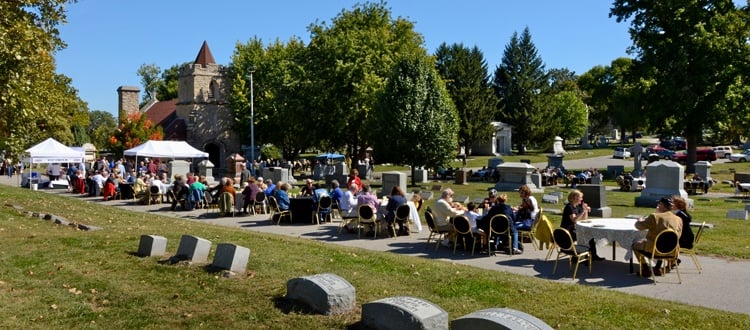A picnic is defined as a meal eaten outside as part of an excursion, usually in the summer, in scenic surroundings such as a park, lakeside, or other location with an exciting view, or in conjunction with a public event such as preceding an open-air theater performance. But did you know that people used to have picnics in cemeteries before parks became popular?
Snacking in cemeteries was common in the United States during the nineteenth century, particularly in later years. It wasn’t just apple-munching along winding graveyard avenues. Many municipalities lacked adequate recreational areas, many people held full-fledged picnics in their local cemeteries.
Picnics in the Cemetery
A little digging in America’s oldest and most historic cemeteries reveals some fantastic snapshots of past picnicking customs. Early photographs show lines of men and women making their way to leafy burial grounds for a perfectly innocent day out.
There are several reasons why nineteenth-century picnics were more morbid than nowadays. To begin with, widespread disease and poverty meant that mortality rates and life expectancy were significantly lower for everyone. Death was an everyday occurrence.
Though tragic, it also meant that many people were more aware of their mortality. As a result, a visit to the cemetery would not have felt so strange.
For many, visiting cemeteries was the only way to reconnect with loved ones who had died before their time. Away from the squalor of the inner city, families would gather around the graves of their children, parents, brothers, and sisters, swapping stories and sharing food.
Visitors were drawn to the cemetery for more than just the opportunity to unwind. In an era before public parks, relatively green graveyards offered a respite from the city’s increasingly dirty, grey, and polluted streets.
Food is not the only historical example of families using food as an excuse to spend time with deceased loved ones.
For example, in Ancient Rome, the parentalia was an annual celebration that honored the spirits of deceased ancestors. Family members transported a carefully prepared banquet to offer to the spirits of deceased relatives before dining around the tomb.
Cemeteries are no longer used for recreation, and many people consider children playing in a cemetery to be disrespectful. Cemeteries have become creepy places, with few visitors other than family members or vandals. Some are completely abandoned. (Source: Atlas Obscura)
Is it Still Possible to Have a Picnic in a Cemetery Today?
Despite this long-standing link, the American obsession with graveyard dining began to fade in the twentieth century.
Rapid medical advancements reduced the threat of premature death. Furthermore, new networks of public parks began to spring up across the country. This made American families far less concerned with spending their free time with the dead.
Because of concerns about littering, many cemeteries have outright prohibited the practice. However, some American cemeteries still allow picnickers to bring their food onto the grounds.
Away from the United States, cultures worldwide continue to offer food to departed ancestors. Food’s significance in spirituality and religion cannot be overstated. (Source: Twisted Food)
